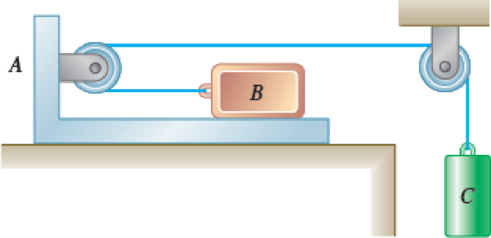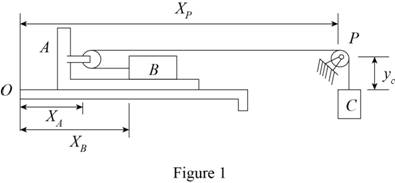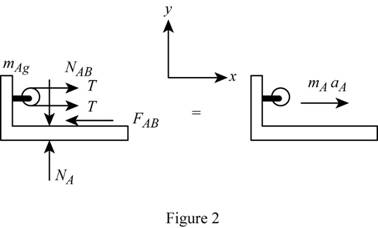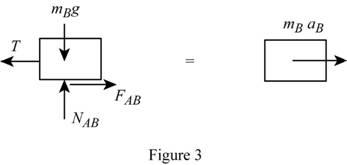
A 10-lb block B rests as shown on a 20-lb bracket A. The coefficients of friction are μs = 0.30 and μk = 0.25 between block B and bracket A, and there is no friction in the pulley or between the bracket and the horizontal surface. (a) Determine the maximum weight of block C if block B is not to slide on bracket A. (b) If the weight of block C is 10 percent larger than the answer found in a, determine the accelerations of A, B, and C.
Fig. P12.31

(a)
Find the maximum weight of block C if block B is not to slide on bracket A.
Answer to Problem 12.31P
The maximum weight of block C if block B is not to slide on bracket A is
Explanation of Solution
Given information:
The weight of block B
The weight of bracket A
The coefficient of static friction between block B and bracket A
The coefficient of kinetic friction between block B and bracket A
Calculation:
Let as consider the horizontal coordinate of A is
left of A.
Let as consider the horizontal coordinate of B is
left of A.
Let as consider
Sketch the system with coordinates points as shown in Figure (1).

Write the general equation of mass (m):
Here, W is the weight, g is the acceleration due to gravity.
Consider the constraint of cord.
Write the total length of cable length (L).
Here,
Differentiate Equation (1) with respect to t to write velocity of the blocks.
Here,
Differentiate Equation (2) with respect to t to write acceleration of the blocks.
Here,
No slip between bracket A and block B. Therefore, the acceleration of bracket A is equal to acceleration of block B.
Substitute
From Equation (4) and (5), consider
Sketch the free body diagram and kinetic diagram of bracket A as shown in Figure (2).

Refer Figure (2).
Apply Newton’s law of equation along x-axis.
Here, T is the tension in the cable,
Substitute
Here,
Sketch the free body diagram and kinetic diagram of block B as shown in Figure (3).

Refer Figure (3).
Apply Newton’s law of equation along x-axis.
Substitute
Here,
Apply Newton’s law of equation along y-axis.
Here,
Write the equation of frictional force
Substitute
Sketch the free body diagram and kinetic diagram of block C as shown in Figure (4).

Refer Figure (4).
Apply Newton’s law of equation along y-axis.
Substitute
Here,
Adding Equation (5), (6), and (9).
Substitute Equation (6) in Equation (12).
Subtract Equation (6) and (9).
Substitute Equation (6) and (10) in Equation (14).
Subtracting Equation (13) and (9).
Substitute 0.30 for
Thus, the maximum weight of block C if block B is not to slide on bracket A is
(b)
Find the accelerations of bracket A, block B and block C.
Answer to Problem 12.31P
The accelerations of bracket A is
The accelerations of block B is
The accelerations of block C is
Explanation of Solution
Given information:
The weight of block C is 10 % larger than the answer found in part (a).
Calculation:
Find the weight of block C.
The slip is occurring. Therefore consider the kinetic acceleration.
Write the equation of frictional force
Substitute
Subtract Equation (6) and (9).
Substitute Equation (17) in Equation (18).
Substitute 0.25 for
Rewrite the Equation (5).
Substitute 10 lb for
Find the accelerations of bracket A, block B and block C.
Solve Equation (3), (20), and (21).
Thus, the accelerations of bracket A is
Thus, the accelerations of block B is
Thus, the accelerations of block C is
Want to see more full solutions like this?
Chapter 12 Solutions
Vector Mechanics for Engineers: Statics and Dynamics
Additional Engineering Textbook Solutions
HEAT+MASS TRANSFER:FUND.+APPL.
Fox and McDonald's Introduction to Fluid Mechanics
Thinking Like an Engineer: An Active Learning Approach (3rd Edition)
Fundamentals of Aerodynamics
Statics and Mechanics of Materials
Thermodynamics: An Engineering Approach
- Two identical chairs, each weighing 14 lb, are stacked as shown. The center of gravity of each chair is denoted by G. The coefficient of static friction is 0.2 at B (the contact point between the chairs) and 0.35 at A, C, and D. Determine the smallest force P that would cause sliding.arrow_forwardThe blocks A and B of weights WA and WB are joined by a rope that passes over the fixed peg C. The coefficients of static friction are =0.2 between block A and the inclined plane, and =0.25 between the rope and the peg. Determine the range of Wb/WA for which the system will be in equilibrium.arrow_forwardA wedge is used to prop up the 6000-lb block of marble. The wedge angle is =30, and the angle of static friction is s=12 between all contact surfaces. Determine the smallest force P that would prevent the wedge from sliding out.arrow_forward
- The 600-lb cable spool is placed on a frictionless spindle that has been driven into the ground. If the force required to start the spool rotating is F = 160 lb, determine the coefficient of friction between the ground and the spool. Neglect the diameter of the spindle compared to the diameter of the spool.arrow_forwardFind the largest value of b/h at which the folding table is in equilibrium. The coefficients of static friction are 0.5 at A and 0.3 at C. Neglect the weight of the table.arrow_forwardFind the smallest distance d for which the hook will remain at rest when acted on by the force P. Neglect the weight of the hook, and assume that the vertical wall is frictionless.arrow_forward
- SITUATION 2: A packing crate of mass 40 kg is pulled by a rope as shown. Knowing that the coefficient of static friction between the crate and the floor is 0.35, answer the following questions: 4. If α = 40°, determine the magnitude of the force P required to move the crate, in N. (ANSWER: 139) 5. If the crate must be moved to the left along the floor without tipping, determine the largest allowable value of α in degrees. (ANSWER: 58)arrow_forwardTwo blocks are being pushed along an incline. Block A weighs 7.00 kg and block B weighs 14.00 kg. The coefficient of non-sliding friction between block B and the surface of the incline is 0.200 and the coefficient of sliding friction is 0.1000. Assume that the coefficient of friction between the two blocks are too high to cause sliding between the two blocks. The applied force is 185 N. 185 N 40° 5. Which of the following gives the closest value to the magnitude of the acceleration of both blocks? 1.752 m/s2 1.000 m/s2 6.16 m/s2 3.21 m/s2arrow_forwardTwo forces, F, and F2, act on the 7.00-kg block shown in the drawing. The angles made by the forces with horizontal are equal to 40°. The magnitudes of the forces are F, = 59.0 N and F2 = 49.0 N. The coefficient of kinetic friction between the block and the surface is 0.1. F2 F1 ...*. ..... а. Draw a free body diagram to show all forces and their components. b. Determine the kinetic friction force. С. What is the horizontal acceleration (magnitude and direction) of the block?arrow_forward
- the system blocks shown below is in equilibrium, the weight of block A is 10 kN and for block B is 35 kN . The coefficient of friction between A and surface is 0.2 and between two block A and B is 0.15. Answer :the following P=40KN The value of friction force between * block A and its surface is 4.0 kN 5.5 kN 6.2 kN O Non above-mentionedarrow_forwardTwo blocks A and B weighing 3 kN and 15 kN, respectively, are held in position against an inclined plane by applying a horizontal force P as shown in Fig. Find the least value of P which will induce motion of the block A upwards. Angle of friction for all contact surfaces is 12°.7.arrow_forwardA 60-kg cabinet is mounted on casters that can be locked to prevent their rotation. The coefficient of static friction between the floor and each caster is 0.35. 3. If h = 600 mm, determine the magnitude of the force P (in N) required to move the cabinet to the right if the casters at A are locked and the casters at B are free to rotate. (ANSWER: 72.5)arrow_forward
 International Edition---engineering Mechanics: St...Mechanical EngineeringISBN:9781305501607Author:Andrew Pytel And Jaan KiusalaasPublisher:CENGAGE L
International Edition---engineering Mechanics: St...Mechanical EngineeringISBN:9781305501607Author:Andrew Pytel And Jaan KiusalaasPublisher:CENGAGE L
